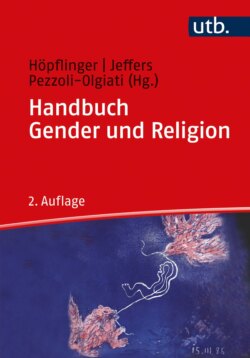Читать книгу Handbuch Gender und Religion - Группа авторов - Страница 60
Internetquellen
ОглавлениеWikipedia, Dorothy Garrod: https://en.wikipedia.org/wiki/Dorothy_Garrod (aufgerufen am 22.09.2019).
Wikipedia, Sue Hamilton: https://en.wikipedia.org/wiki/Sue_Hamilton_(archaeologist) (aufgerufen am 22.09.2019).
Wikipedia: WikiProject Archaeology / Women in archaeology taskforce: https://en.wikipedia.org/wiki/Wikipedia:WikiProject_Archaeology/Women_in_archaeology_task_force (aufgerufen am 21.09.2019).
Wikipedia, Women’s Classical Committee: https://en.wikipedia.org/wiki/Wikipedia:Women%27s_Classical_Committee (aufgerufen am 22.09.2019).
1 Dieser Artikel wurde vom Englischen ins Deutsche von Caterina Panunzio übersetzt. Die meisten direkten Zitate wurden ebenfalls aus dem Englischen übersetzt. Die Originalzitate wurden in die entsprechenden Fußnoten eingefügt.
2 Meskell/Joyce (2003), 4: »Archaeology offers a counter to the documentary and iconographic record produced by an all-male elite, in that it can shed light on the silent masses – women, children, foreigners, the non-elite and individuals of servile status.«
3 Meyers (2017), 519: »intertwined urban and male bias«.
4 Meskell/Joyce, (2003), 4: »hint at more subversive trends that explicitly defy the hegemony of the textual record«.
5 Gero/rev. Sørensen (2012), 594: »the investigation of the role and meanings of gender in the past«.
6 Matić/Jensen (2017), 2: »unexamined androcentric beliefs and gender mythologies and to demand arguments and evidence for them«.
7 Vgl. Rubin (1997).
8 Gero/rev. Sørensen (2012), 594: »of being made and remade«.
9 Gero/rev. Sørensen (2012), 595: »are articulated in the archaeological record«.
10 Vgl. Nelson (2006), 1–27.
11 Vgl. Bertelsen/Lillehammer/Næss (1983).
12 Vgl. Gero/Conkey (1991).
13 Bahn (1992), 321: »The latest outbreak – which bears a great resemblance to the good old days of New Archaeology (primarily a racket for the boys) – is gender archaeology which is actually feminist archaeology (a new racket for the girls). […] Hardly a month goes by without another conference on ›gender archaeology‹ being held somewhere by a host of female archaeologists (plus a few brave or trendy males who aspire to political correctness). Some of its aims are laudable, but the bandwagon shouldn’t be allowed to roll too far, as the new archaeology did, before the empresses’ lack of clothes is pointed out by gleeful cynics.«
14 Vgl. Gilchrist (1999); Joyce (2008).
15 Vgl. Hamilton/Whitehouse/Wright (2007), in Anlehnung an Díaz-Andreu/Sørensen (1998) im Bereich Europäische Archäologie.
16 Vgl. https://en.wikipedia.org/wiki/Wikipedia:WikiProject_Archaeology/Women_in_archaeology_task_force
17 Vgl. https://en.wikipedia.org/wiki/Dorothy_Garrod; https://en.wikipedia.org/wiki/Sue_Hamilton_ (archaeologist)
18 Vgl. Schmidt/Voss (2000).
19 Vgl. Prentiss (2016).
20 Brumfiel (2006), 31: »with the inclusion of women, men, and other genders into a single frame of analysis«.
21 Brumfiel (2006), 34: »to identify the extent of difference between gender categories«.
22 Vgl. https://en.wikipedia.org/wiki/Wikipedia:Women%27s_Classical_Committee
23 Vgl. Gero/rev. Sørensen (2012), 595.
24 Zuvor nur von Gilchrist (1999) thematisiert.
25 Vgl. Matić/Jensen (2017).
26 Vgl. Gilchrist (1999).
27 Vgl. Moraw (2017), 151–178.
28 Moraw (2017), 175: »need a male participant for their pornographic effect«.
29 Moraw (2017), 153: »the presentation of females in a way that sexualises and objectifies them, often violently«.
30 Moraw (2017), 153: »the essence of gender relations in a patriarchal society«.
31 Vgl. Dworkin (1979).
32 Vgl. Nelson (2011), 198.
33 Vgl. Gero/Conkey (1991).
34 Vgl. Nakhai (2019).
35 Vgl. Nakhai (2019).
36 Vgl. Beck (1982).
37 Stavrakopoulou (2010), 42: »across socio-religious groups in Israel and Judah, from rural households to elite city-dwellers«.
38 Vgl. Garroway (2018).
39 Vgl. Janssen (2018); Janssen/Janssen (1990).
40 Nakhai (2014), 167.
41 Vgl. Conkey/Tringham (1995).
42 Vgl. Buden (2002).
43 Moraw (2017), 152.
44 Vgl. Janssen (2018), 9–25.
45 Meskell/Joyce (2003), 4.
46 Meyers (1997), 279.
47 Meyers (1997), 279: »especially acute with respect to who used them«.
48 Hjørungdal (1994), 144.
49 Vgl. Whitehouse (2017), 223–246.
50 Vgl. Magness (2002), 182–185.
51 Vgl. Taylor (1999), 285–323.
52 Lim/Collins (2010), 3: »no topic related to the Dead Sea Scrolls has been more controversial than the archaeology of Khirbet Qumran«.
53 Sørensen (2000), 79.
54 Matić/Jensen (2017), 2: »based on a historically contingent division of work and tasks, found in so-called ›Western‹ societies«.
55 Vgl. Nelson (2004), 111.
56 Vgl. Meyers (2017), 524.
57 Meyers (2017), 529.
58 Meyers (2017), 529: »a more balanced situation of gendered power in households than is implied by biblical texts«.
59 Vgl. Meyers (2017), 527.
60 Dijkstra (2001), 171: »the division of labour usually ties women […] to the house, and to tasks indoors«.
61 Wie zum Beispiel in der Eisenzeit IIA-Stätte von Tel Rehov. Mazar (2016), 50e–51e.
62 Vgl. Samuel (1999), 121–144.
63 Deutsche Übersetzung: Lutherbibel 2017.
64 Meyers (2017), 526.
65 Whitehouse (2017), 242: »presented easy access to attractive answers«.
66 Vgl. Meyers (2017), 519.
67 Gero/rev. Sørensen (2012), 595.
